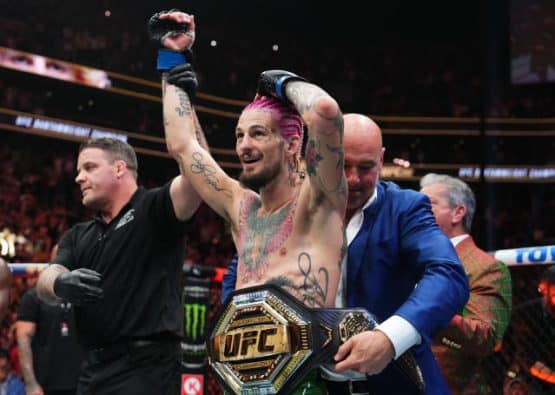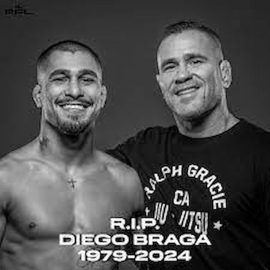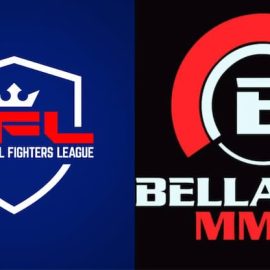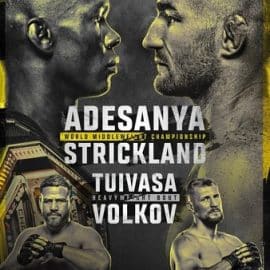BELLATOR RISING
How to Compete With the UFC
Bellator has all the tools to become a major player in the mixed martial arts realm. Granted they’re the number-two MMA promotion in the world, but this has happened by default. UFC’s dominance has earned them over 90% market capitalization of the MMA industry, creating more-or-less a virtual monopoly and spawning immeasurable advantages for the company that just sold for $4.2 billion. Not the least of these are:
- Talent: Of the top ten fighters in each weight class, UFC averages to have at least nine under contract. The next 20-40 ranked fighters in each division are most likely also signed to the UFC.
- Merchandising: UFC’s overbearing contracts allow the promotion to capitalize on the names and likenesses of their contracted fighters, leveraged completely to UFC’s favor. This allows them to use the star power of hundreds of UFC-contracted athletes to sign lucrative licensing deals, including apparel, video games, toys, and other merchandise—also advantaged to UFC’s benefit, rather than the fighters who are being capitalized off of.
- Sponsorships: When UFC fighters had a second income in the form of sponsorships, the UFC saw a lost revenue stream for themselves. So they signed a notoriously-unfavorable sponsorship deal with Reebok, which forced UFC fighters to give up their personal sponsors (and the sizable amount of income that came with them), and accept pennies on the dollar to represent Reebok—and Reebok only. Though this self-serving move by the UFC was widely criticized by the MMA industry, it created an opportunity—one that a “number-two by default” company like Bellator critically needed to become a serious competitor.
But do we need a competitor to the UFC? Isn’t it great to just have all of the top fighters in one promotion?
This is a debate that was had during the romanticized “UFC-versus-Pride” era, where there were indeed two MMA juggernauts competing on a global stage, which not only created more jobs in the industry, but also generated interest in “dream fights.”
What if Wanderlei Silva, a Brazilian berserker viciously knocking out top light heavyweights in Pride, faced the Californian Chuck Liddell, who was doing likewise in the UFC? Could Pride Heavyweight Champion Fedor Emelianenko really be considered the greatest heavyweight of all time when he hadn’t fought Tim Sylvia, Andrei Arlovski, or Randy Couture? How would Pride’s Mirko “Cro Cop” Filipović manage against those same UFC heavyweights?
The marquee value that was organically built up as a result of these dream fights was something I used to call the “two-mountain effect.” When you’re on one mountain looking across the valley to another sierra, it makes you wonder what it’s like over there. If conditions are better. If there’s more success to be had. And for the MMA fighter, if there’s more money to be made. For the MMA audience, it makes them wonder how the king standing atop of one mountain would fare against the summiter of the opposing hill.
This fantasy has been lost since the UFC purchased Pride and seized control of the industry for themselves. With one mountain, these dream scenarios don’t exist, the answers to “who’s the best?” are constantly answered, and ironically, not a lot of people care when they are.
In an alternative universe, Demetrious Johnson is the UFC flyweight champion, John Dodson is the flyweight champion of the other big MMA outfit, and when a deal is reached to have them fight, it’s a huge deal—much in the same way Andre Ward boxing Sergey Kovalev is a big deal. In this universe, the first title fight between Johnson-Dodson was on a throwaway Fox card, and the rematch was the lowest PPV buy rate since the UFC’s rise to prominence.
Also lost are the competitive bidding wars over talent that resulted from trying to have these questions answered, which has (again) favored the company that holds the virtual monopoly. This has negatively affected the livelihoods of MMA athletes by limiting their bargaining power.
The “catch 22” here is that although having all fighters under one umbrella easily gives us the fights we otherwise wouldn’t have gotten to see, it doesn’t mean anything when we do see them because there’s no barrier to them—eliminating interest. But when there are “two mountains,” all we think about are dream fights because the barrier, itself, generates the interest.
This is one of the many reasons that although it doesn’t always seem like it, it behooves us to want to have more than one successful MMA operation. It’s better for the fighters, it’s better for industry, and ultimately, it’s better for the fans.
As the opening line said, Bellator has the tools to become a strong competitor to the UFC. Owned by an entertainment conglomerate in Viacom, run by a knowledgeable promoter like Scott Coker, and showcased by a dedicated distribution outlet like Spike TV collectively creates a domestic platform that can only be compared to the Turner-owned World Championship Wrestling in the mid-90s (which ultimately became a very real competitor to the domineering World Wrestling Federation, and the positive effects of healthy competition in the professional wrestling industry lasts to this day).
The question is then asked: what does Bellator have to do to compete against the UFC?
Tentpole Megashows
Bellator needs more of these, and they should be treated as the equivalent of a monthly UFC PPV.
Bellator President Scott Coker had the right idea when he started signing big-name superstars from UFC’s yesteryear. Although not the preferred matchmaking for the “hardcore fan,” bouts like Royce Gracie-Ken Shamrock III and Tito Ortiz-Stephan Bonnar set viewership records for Bellator. And ultimately, this is a business predicated on ratings and advertising revenue.
The last “tentpole” event as of this writing occurred on June 24, 2016, and was headlined by an underwhelming bout (both on paper and in actuality) between Quinton “Rampage” Jackson and Satoshi Ishii. The next one will happen on January 21, 2017, and will feature a far superior marquee bout between Ortiz and Chael Sonnen.
These are too few and far between. Although it’s smart for Bellator not to wear themselves thin and spread talent over many events, they’re not going to generate the necessary excitement needed to be noticed in the MMA world with semi-annual megashows.
Wishing Upon a Star
In order to set up these megashows, Bellator needs more established names on their roster. Especially with the loss of Kimbo Slice due to his untimely death, and the likely conclusions of Ken Shamrock’s and Royce Gracie’s careers earlier this year, those are three big names Bellator won’t be able to capitalize on anymore.
The signing of Chael Sonnen fills the void somewhat, but not as much if we’re to consider that his upcoming fight against Tito Ortiz will likely be Ortiz’s last. Bellator is running out of stars far quicker than they are making (or acquiring) them.
The recent rumor of a targeted Fedor Emelianenko-Matt Mitrione bout on a Bellator show suggests that Scott Coker will attempt to fill the void once more with the mythical Emelianenko, but eventually, Coker’s going to run out of established names to sign.
It then becomes imperative to figure out ways to make homegrown talent like Michael Chandler and Hisaki Kato bigger deals to the casual audience. Signing free agents who have become disillusioned with the UFC’s business practices like Benson Henderson, and booking them against in-house fighters like Chandler seems to be an excellent way to further the latter’s star power—but only if he wins. Chandler suffered two losses to Will Brooks, who then defected to the UFC (and has since lost), hurting the perception of Chandler as a top lightweight, and necessitating him to spend years rebuilding his momentum.
The same will hold true for Andrey Koreshkov, Michael Page, Liam McGeary, and other Bellator fighters if and when they fight UFC-established names like Rory MacDonald and Phil Davis. This is where UFC’s predominant grasp over MMA’s top talent holds yet another advantage for them—a lot of these free agents are “UFC-branded,” and will always be perceived as such by the MMA audience.
And then, no matter who it is, there’s always the risk that however hard a company like Bellator tries to develop their own stars, some might just defect to the UFC anyway for increased money and exposure (like Brooks, Hector Lombard, and Eddie Alvarez did).
The “Rush” of Adrenaline
Although the subheading implies that Bellator needs to try their hand at signing former UFC megastar Georges St-Pierre (if he’s available and not locked under his previous UFC agreement), the real implication here is that Bellator needs to make a major move. A coup, in other words, to generate an insanely high amount of buzz for the Bellator brand in one fell swoop.
This would most likely be snatching a top star from the UFC’s grasp when nobody’s expecting it. This was what ignited the aforementioned WWF-WCW war, when WCW Executive Vice President Eric Bischoff signed WWF superstar Hulk Hogan while the WWF thought they didn’t need him. Could Georges St-Pierre be Bellator’s Hulk Hogan?
When UFC Interim Featherweight Champion José Aldo revolted against the UFC after the Eddie Alvarez-Conor McGregor booking, and demanded to be let out of his UFC contract, many expected him to be Bellator’s eventual coup. However, UFC used every last legality of its restrictive talent contract to keep Aldo locked down, hinting that they might now be cognizant of Bellator as a safe haven for frustrated UFC exiles.
St-Pierre’s teammate Rory MacDonald made a high-profile move to Bellator earlier this year, and if Bellator can secure an even bigger name from the UFC (like St-Pierre himself), it may just be the preemptive strike in a future UFC-Bellator war.
Viamoney
We don’t know much about how Viacom views Bellator as one of their subsidiaries, nor about Viacom’s long-term outlook for their in-house MMA league. However, we do know that if Viacom really wanted to, they do have the resources to make Bellator a prominent sports entity—enough to be competitive with the UFC.
So why don’t they?
A lawsuit filed against Viacom / Bellator alleged that Viacom strategically used Bellator to divert advertising revenue from Bellator productions elsewhere within their company, rather than to Bellator itself, and at the expense of Bellator’s profitability. If true, this would imply that Bellator is merely a business vehicle so that Viacom can achieve its own goals, and building a respectable sports league is not a priority in Viacom’s grand vision.
With the recent $4.2 billion sale of the UFC, one would imagine that the incredibly high (and inflated) value of the UFC would’ve encouraged Viacom to dedicate a special focus in building Bellator to a multi-billion-dollar brand since the potential is apparently there—especially right now during the vulnerable transitional period that the UFC is undergoing, with significant downsizing and job cuts.
Whether Viacom intends to do such remains to be seen, but to attract the likes of Georges St-Pierre and Fedor Emelianenko will cost money that Bellator itself might not have. The onus will then be on Viacom to either step up, or step back.
Bellator’s on This Week? When?
Though watching Bellator on Spike TV might be difficult for some (in an age where cable subscription fees are through the roof, and cord-cutting is a preferential way to deal with this), if there’s a will, then there’s a way. But the problem is: there doesn’t appear to be a will.
Bellator has always had a huge issue which has gone unaddressed throughout the company’s existence: not a lot of people know when a Bellator show is on.
It would require going to Bellator’s website, an MMA news site, or Wikipedia to find out the date / time of the next Bellator event. However, there needs to be an initial “urge” to seek out this information. Marquee bouts with built-in buzz (like Kimbo Slice-Ken Shamrock) would’ve created this initial urge, as would most UFC shows due of their enormous grasp on the market, but what about a Joe Warren-headlined Bellator card?
They can throw a thousand commercials on Spike TV, but chances are the casual audience isn’t watching Spike TV 24/7. They can diversify their marketing strategy by targeting digital media, but throwing dates / times in commercials is an advertising method that’s becoming “1980s-ish.”
Consumers will find a product if they’re interested in doing so, which is why HBO’s “Westworld” has succeeded “Game of Thrones” as being the premium network’s must-watch appointment programming.
Bellator must also make their events appointment television, and simplify the MMA audience’s pathway to their broadcasts by establishing a consistency to their shows. As of this writing, these are the dates / times of Bellator’s remaining events in 2016:
- Friday, November 11: Koreshkov vs. Lima (9:00 PM EST). Author’s Note: This event will take place on Thursday, November 10, and will air on a delay the next day.
- Saturday, November 19: Chandler vs. Henderson (9:00 PM EST)
- Friday, December 2: Dantas vs. Warren 2 (9:00 PM EST)
- Saturday, December 3: Pitbull vs. Campos 2 (9:00 PM EST)
- Saturday, December 10: Carvalho vs. Manhoef 2 (9:00 PM EST)
- Friday, December 16: King Mo vs. Ishii (9:00 PM EST)
What we can see here is that there’s a very good consistency with timing of broadcasts. If an MMA fan has an inkling that a Bellator event might be on that week, there’s a good possibility they’ll know to tune in at 9 PM Eastern—if they know the date.
There are two areas where the scheduling of Bellator events are erratic. The obvious inconsistency is that certain events take place on Friday, while others on Saturday. The other inconsistency is that there doesn’t appear to be a logic as to which weeks have an event (or events), so a potential viewer wouldn’t be able to rely on memory to guess when a Bellator show might air. It’s a variable, so the solution has to be sought out—already too much to ask for from the casual audience in this day and age.
There’s a fix to this problem, and we again look to the world of professional wrestling to see how Bellator can become appointment TV. WWE maintains their viewership by having a consistent date / time to their flagship show, “Monday Night Raw,” each week. If “Raw” was spread out on different days throughout the week (let alone certain weeks not having an episode, while other weeks having two), it would create the same difficulty that Bellator faces in maintaining consistent viewership.
Since Bellator held 22 events in 2016, that allows for just about enough broadcasts to do a bi-weekly show on a certain day of the week (with four preemptions). They’ve got a static time: 9 PM Eastern, now Bellator has to settle on a fixed day (whether that’s Friday or Saturday), and air an event every two weeks exactly. It’s obviously a logistical challenge (otherwise, they would be doing this already), but as we’ve seen elsewhere, it’s not an insurmountable task.
Let MMA viewers “create a routine” to watch Bellator, and reap the benefits of consistent viewership.
If the Gladiator Helmet Falls
I recently wrote a piece about the fall of Affliction MMA, and the main crux of why Affliction burned out so quickly was because they attempted to do too much too soon. Their MMA endeavors were backed by their apparel company, which, in turn, was bolstered by UFC exposure. By engaging in a war against the UFC and getting banned from their events, Affliction’s base business suffered, and thus their MMA company became unsustainable.
Bellator has no such restrictions, and technically, they have far stronger backing with Viacom than the UFC does with WME-IMG. For a company that has been around since 2008, and despite surviving in a business where most have failed, Bellator has made minimal strides since their inception. At some point, they’ll be expected to make a significant move, or forever be condemned as a distant number-two company, and an afterthought in the industry.
As the thesis said, it’s in everyone’s interest to have a strong competitor to the UFC (except, perhaps, the UFC themselves). Competition breeds excellence, as it does interest, and for a sport that is still just teetering on the edge of mainstream acceptance, we cannot limit ourselves to being an industry virtually monopolized and serving the needs of one corporation. There has to be other places for MMA fighters to compete. And there has to be money to pay them, and to make this sport a viable option for an aspiring athlete.
Co-promoting with Japan’s RIZIN Fighting Federation is a great way to break down barriers and create match-ups that would interest the MMA audience. Bidding for the likes of Rory MacDonald and Matt Mitrione is great for engineering a competitive marketplace, which benefits the fighters. Allowing personal sponsorships, so fighters can earn significantly more than their show money and win bonus, is also a great incentive to attract top talent. And putting it all on Spike TV, which is a free outlet for those who have cable in the United States and Canada, is a luxurious benefit to MMA fans.
No doubt about it, Bellator is doing a lot of things right. They just need to do more.
Add The Sports Daily to your Google News Feed!














